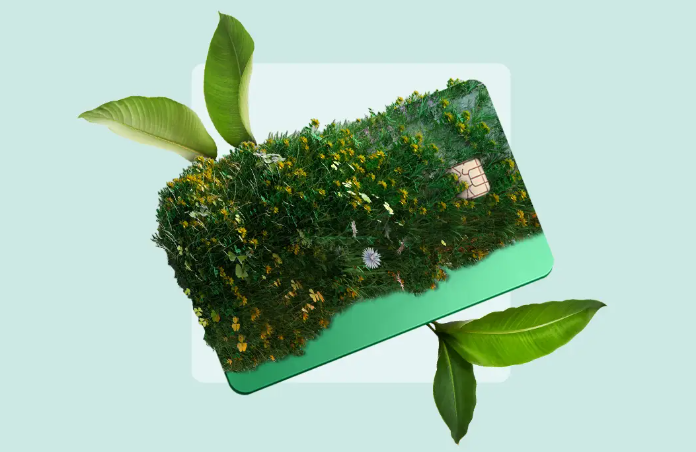Introduction:
In today's rapidly evolving world, sustainability is more than just a buzzword. It's a commitment, a lifestyle, and for many, a responsibility. Just when we thought we had seen it all in the financial sector, a new revolution is taking shape: the Green Card Revolution. This isn't about immigration or citizenship – it's about the credit card industry's pivot towards eco-friendly practices. A change driven not just by environmental concerns, but also by the consumers who use these cards daily. Ever wondered about the impact your credit card has on the environment? Well, you're about to find out.

The Environmental Impact of Traditional Credit Cards:
Think about it for a moment. How many credit cards have you owned in your lifetime? Now multiply that by billions of users worldwide. Traditionally, credit cards have been made from PVC (polyvinyl chloride), a type of plastic notorious for its non-biodegradable nature. This means when a card expires, it doesn't just fade away. It remains, contributing to the mounting plastic waste issue our planet faces.
Moreover, the manufacturing process of these cards isn't exactly green either. From the extraction of raw materials to the production and distribution, the carbon footprint is significant. And with finance being a crucial part of our lives, it's time to ask: Is there a better way?
The Rise of Eco-Friendly Credit Cards:
Enter the age of the Green Credit Card. These aren't your typical plastic cards. Made from sustainable materials like bioplastics, recycled PVC, or even wood, they represent a seismic shift in the credit card industry's approach. But it's not just about the materials. Many of these cards also come with eco-friendly perks. Imagine earning rewards not just for spending but for planting trees or supporting renewable energy projects? The benefits are twofold: they incentivize sustainable consumer behavior while also reducing environmental impact.
Did you know that a recent episode of [Popular TV Show] highlighted the pressing need for sustainable practices in everyday finance? The episode shed light on the alarming environmental costs of traditional banking and finance tools. It was a wake-up call for many, leading to a surge in demand for green financial options.
Comparing Traditional and Green Credit Cards:
| Feature | Traditional Credit Cards | Green Credit Cards |
|---|---|---|
| Material | PVC (Non-biodegradable) | Bioplastics, Recycled PVC, Wood |
| Manufacturing Carbon Footprint | High | Reduced |
| Rewards | Cashback, Air miles | Eco-friendly perks like tree planting |
| Lifecycle | Ends up as waste | Biodegradable or recyclable |
So, are you still clutching onto that traditional credit card? The benefits of switching are clear, not just for the planet, but potentially for your wallet too. As consumers increasingly lean towards sustainable choices, financial platforms like Creditwisehub play a pivotal role. They offer insights, advice, and the latest news on green finance, helping users make informed decisions.
How Credit Card Companies Are Adapting:
Change is in the air, and credit card companies aren't staying behind. Major players in the industry are taking note of the green wave. They are not only introducing eco-friendly cards but also aligning their business strategies with sustainable goals. From reducing paper statements to investing in carbon offset projects, their initiatives are diverse and impactful.
One might wonder, what's driving this change? The answer is twofold: consumer demand and the looming threat of climate change. As more people become environmentally conscious, they demand products and services that align with their values. On the other hand, climate change, with its devastating effects, is pushing businesses to adopt sustainable practices, both for ethical reasons and long-term survival.
The Role of Finance Websites Like Creditwisehub:
In this age of information, staying updated is crucial. Especially when it comes to finance, the stakes are high. Websites like Creditwisehub have emerged as beacon lights, guiding consumers through the foggy world of finance. Offering advice, insights, and timely updates, they play an essential role in shaping financial decisions.
But what sets Creditwisehub apart? It's not just about credit cards or loans. It's about responsible finance. By highlighting eco-friendly practices and products, they empower users to make choices that are good for their pockets and the planet. So, the next time you're contemplating a financial decision, a quick visit to Creditwisehub might be the game-changer.
The Future of Green Credit Cards:
So, what lies ahead for green credit cards? The trajectory looks promising. As technology advances, we can expect even more sustainable materials to emerge. Think cards made from seaweed or even mushroom mycelium! Additionally, the rewards systems will likely get more innovative, further promoting sustainable behaviors.
But it's not just about the card itself. The entire financial ecosystem is moving towards greener practices. From digital-only banks reducing paper waste to investments in renewable energy, the future of finance is undoubtedly green.
Conclusion:
The Green Card Revolution is not just a fleeting trend. It's a testament to how industries can evolve to meet the demands of a changing world. As consumers, the power lies in our hands. By opting for eco-friendly credit cards and supporting sustainable practices, we can drive change. And with platforms like Creditwisehub by our side, making informed decisions has never been easier. So, as we stand at the cusp of this green revolution, the question is, are you on board?


